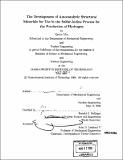| dc.contributor.advisor | Ronald G. Ballinger. | en_US |
| dc.contributor.author | Miu, Kevin (Kevin K.) | en_US |
| dc.contributor.other | Massachusetts Institute of Technology. Dept. of Nuclear Engineering. | en_US |
| dc.date.accessioned | 2007-03-12T17:47:53Z | |
| dc.date.available | 2007-03-12T17:47:53Z | |
| dc.date.copyright | 2006 | en_US |
| dc.date.issued | 2006 | en_US |
| dc.identifier.uri | http://hdl.handle.net/1721.1/36724 | |
| dc.description | Thesis (S.B.)--Massachusetts Institute of Technology, Dept. of Mechanical Engineering; and, (S.B.)--Massachusetts Institute of Technology, Dept. of Nuclear Engineering, 2006. | en_US |
| dc.description | Includes bibliographical references (p. 63). | en_US |
| dc.description.abstract | The Sulfur-Iodine Cycle for the thermochemical production of hydrogen offers many benefits to traditional methods of hydrogen production. As opposed to steam methane reforming - the most prevalent method of hydrogen production today - there are no carbon dioxide emissions. Compared to other methods of hydrogen production, the efficiency of the cycle is excellent. Due to the high temperatures necessary for the cycle, which are generally greater than 8500C, several of the Generation IV nuclear reactor concepts are attractive thermal energy sources. However, the high temperature and corrosive reaction conditions of the cycle, involving reactions including the decomposition of H2SO4 at 400-9000C, present formidable corrosion challenges. The conversion of sulfuric acid to sulfur dioxide was the focus of this study. The alloying of structural materials to platinum has been proposed as a solution to this problem. A catalytic loop to test the materials was constructed. Sulfuric acid was pumped over the material at 903+20C. The sulfur dioxide production of the catalyst was measured as a means of quantifying the efficiency of the system as a function of temperature. | en_US |
| dc.description.abstract | (cont.) The maximum possible production of the material was calculated by using a mass balance. A gas chromatograph was used to calculate the actual production of sulfur dioxide. The results of the experiment show that an molecular conversion efficiency of 10% is attained when operating at 900C while using 800H + 5%Pt as a catalyst. The research confirms the catalytic activity of the material. | en_US |
| dc.description.statementofresponsibility | by Kevin Miu. | en_US |
| dc.format.extent | 63 p. | en_US |
| dc.language.iso | eng | en_US |
| dc.publisher | Massachusetts Institute of Technology | en_US |
| dc.rights | M.I.T. theses are protected by copyright. They may be viewed from this source for any purpose, but reproduction or distribution in any format is prohibited without written permission. See provided URL for inquiries about permission. | en_US |
| dc.rights.uri | http://dspace.mit.edu/handle/1721.1/7582 | |
| dc.subject | Mechanical Engineering. | en_US |
| dc.subject | Nuclear Engineering. | en_US |
| dc.title | The development of autocatalytic structural materials for use in the sulfur-iodine process for the production of hydrogen | en_US |
| dc.type | Thesis | en_US |
| dc.description.degree | S.B. | en_US |
| dc.contributor.department | Massachusetts Institute of Technology. Department of Mechanical Engineering | en_US |
| dc.contributor.department | Massachusetts Institute of Technology. Department of Nuclear Science and Engineering | en_US |
| dc.identifier.oclc | 77562809 | en_US |
